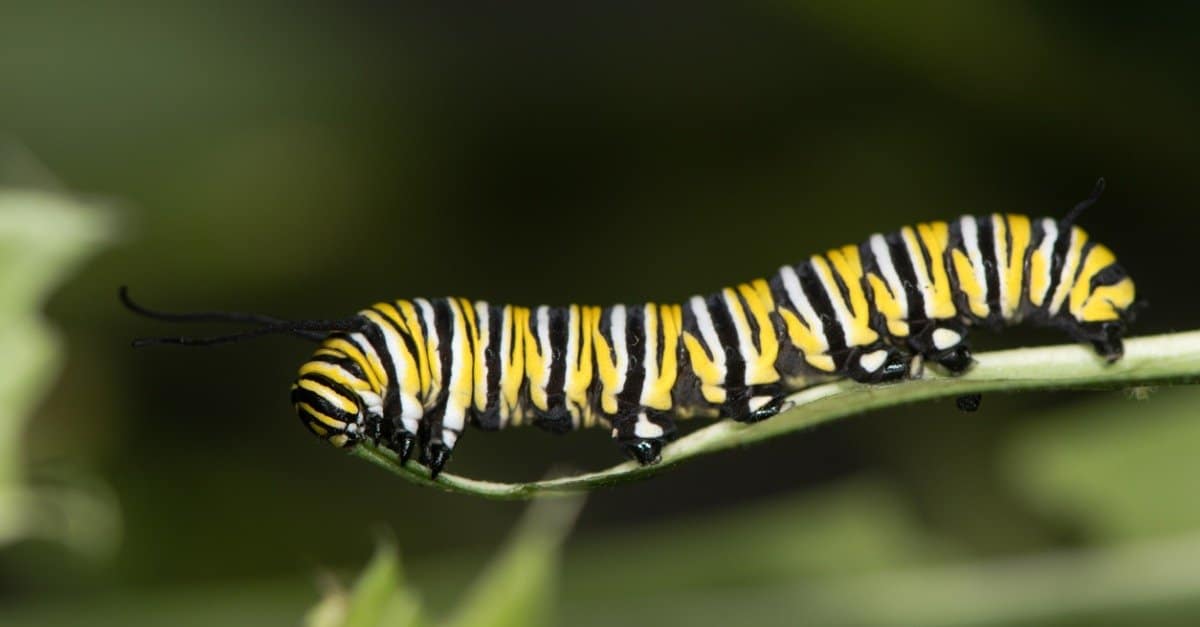From the tiniest southern flannel moth to the beautiful two-tailed swallowtail, many majestic moths and butterflies call Arizona home for at least part of the year. But before these beauties roam the skies, they make their way to land as humble caterpillars.
In this article, we’ll take a look at some of the caterpillars you might encounter in the state of Arizona and find out some interesting facts about each one!
1. Woolly Bear Caterpillar (Pyrhharctica isabella)
While many hairy or spiny caterpillars carry painful venom and should be avoided, the woolly bear caterpillar (Pyrhharctica isabella) is an exception. Its black and reddish-brown hairs are soft and harmless, making it one of many Arizona caterpillars that are perfectly safe to handle.
The woolly bear is quite the popular caterpillar throughout its wide North American range. Many folk legends have it that the insect’s banding can predict the length of the upcoming winter, with a wider center band indicating a longer, harsher season. Though there isn’t any real evidence to support the legends, a couple of towns in the U.S. put on festivals to celebrate the caterpillars’ predictions each year.
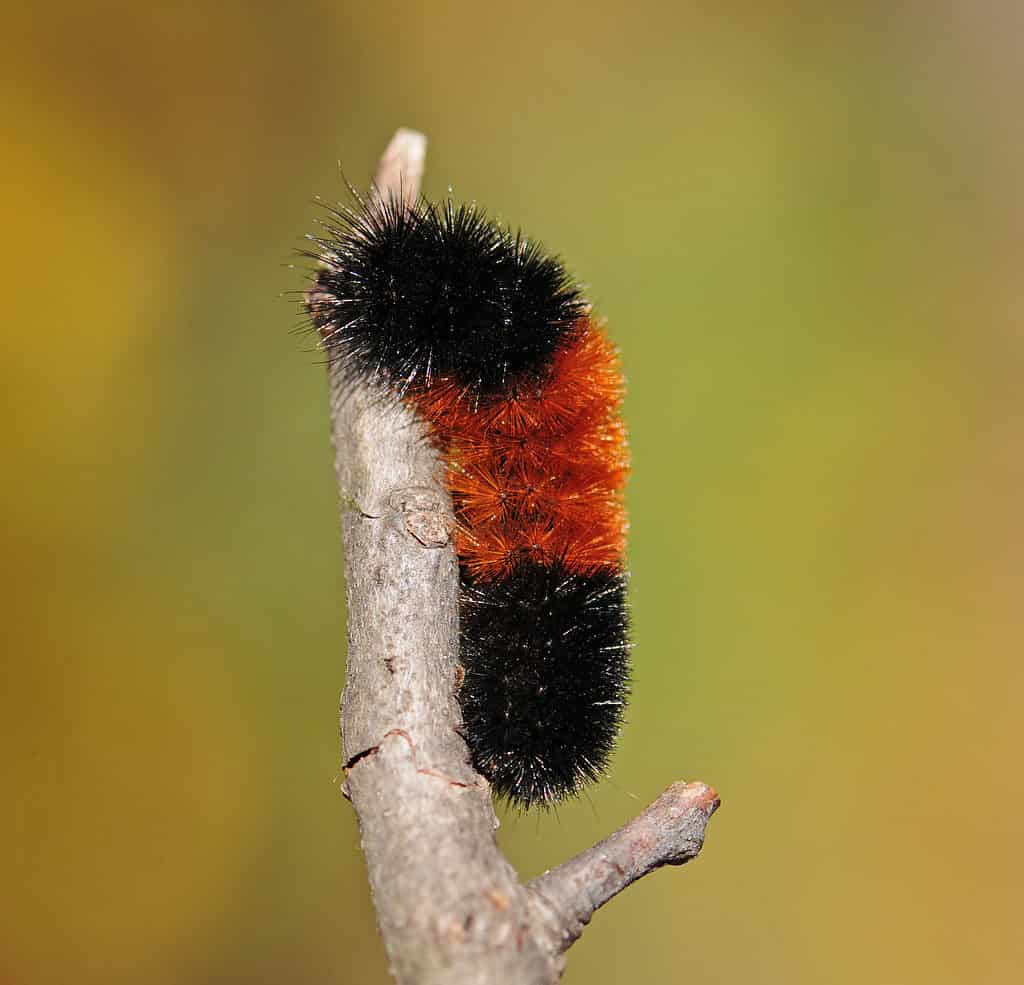
©Nancy Bauer/Shutterstock.com
2. Mesquite Stinger Caterpillar (Norape tener)
First described by English scientist Herbert Druce in 1897, the mesquite stinger caterpillar exists in the southeastern part of Arizona. Its range extends into southern New Mexico and southward into Mexico. True to its name, the mesquite stinger possesses many long, fine, stinging hairs that it uses to protect it from predators. Its close relative, the white flannel moth (Norape ovina), guards itself in the same way. The venom contained within these stinging hairs causes a raised, painful, and itchy rash at the contact site.
Also true to its name, this caterpillar frequently feeds on mesquite trees and other desert plants. Adults of the species are pretty small, measuring only an inch or so in length. Take care when moving through scrub and brush, as these venomous little caterpillars can fall from plants or get stuck in hair and clothing.
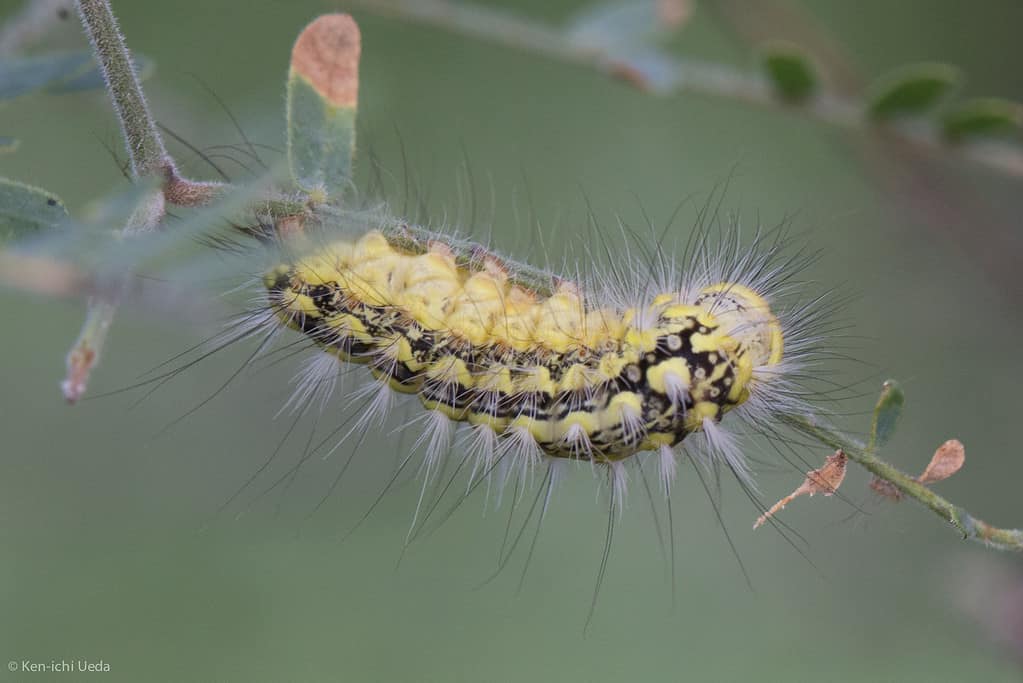
3. White-lined Sphinx Moth Caterpillar (Hyles lineata)
Appearing statewide, this caterpillar is the larval stage of the white-lined sphinx moth (Hyles lineata). Adults of the species are often called hawk moths because of their direct and purposeful flight patterns. Colors and patterns can vary widely between individuals, but all are visually striking and feature mixes of neon green, yellow, and black.
Regardless of coloration, caterpillars of this species feature a single, rear-facing horn on their hind end. This is an example of a survival strategy called automimicry, where an animal mimics part of its own body to increase its chances of survival. Because its rear end looks more like its head than its real one, predators are more likely to target the less vulnerable part of the caterpillar. As long as its head remains intact, the caterpillar is more likely to recover from an attack.

©Wallenrock/Shutterstock.com
4. Painted Lady Caterpillar (Vanessa virginiensis)
The bristly-painted lady caterpillar (Vanessa virginiensis) appears throughout Arizona as well as most of North America during the warmer months of the year. It feeds primarily at night and on overcast days when the temperatures are lower and the sun is less harsh. During the day, it weaves a silken nest to hide in at the tip of its host plant’s leaves.
Once the caterpillar reaches its full size, about an inch-and-a-half in length, it spins an ornate cocoon that eventually gives way to a beautiful orange-and-black butterfly. The butterflies appear throughout the state all year long. As winter approaches and temperatures begin to fall, however, their numbers typically increase as northern butterflies migrate southward to states like Arizona to overwinter.
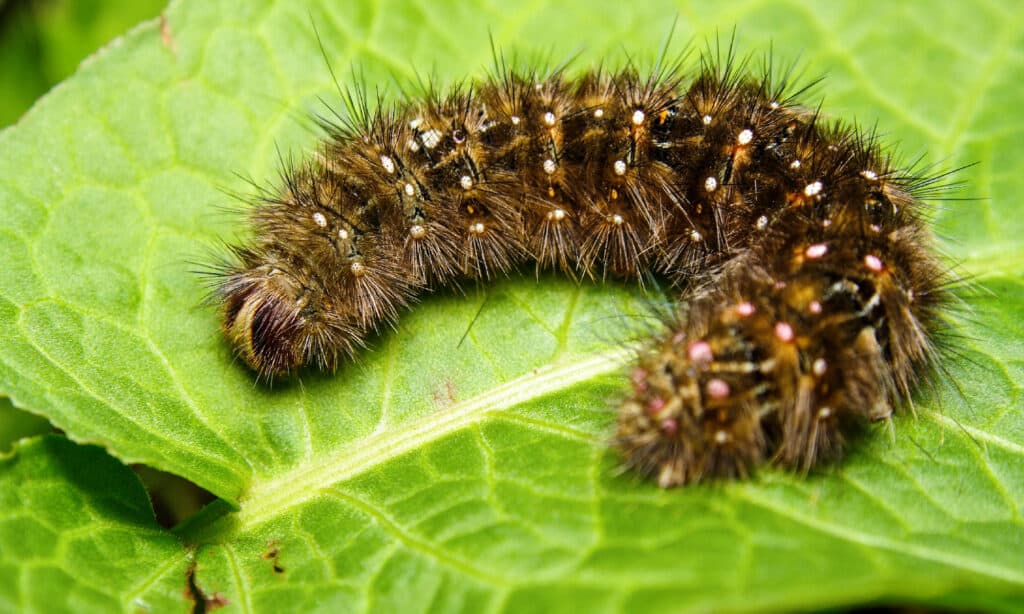
©iStock.com/Andrew Waugh
5. Cabbage Looper (Trichoplusia ni)
Cabbage loopers (Trichoplusa ni) are common garden pests throughout their range, appearing from late April through the end of fall. Despite their common name, these little green inchworms feed on much more than cabbage. Common hosts include Brassica varieties of all kinds, including broccoli, Brussels sprouts, and kale, as well as nightshades like tomatoes and potatoes. If your plant’s leaves are looking a bit ragged, you may want to inspect them for cabbage loopers!
Many predatory insects, like lacewings and ladybugs, feed on these little guys, and some wasps parasitize their eggs to lay their own. The caterpillars are susceptible to a virus known as NPV, which some gardeners take advantage of to protect their crops. By mashing diseased caterpillars into a sprayable liquid and then applying it to their plants, they are able to spread the disease throughout their garden. Caterpillars that feed on their plants then contract the deadly virus.
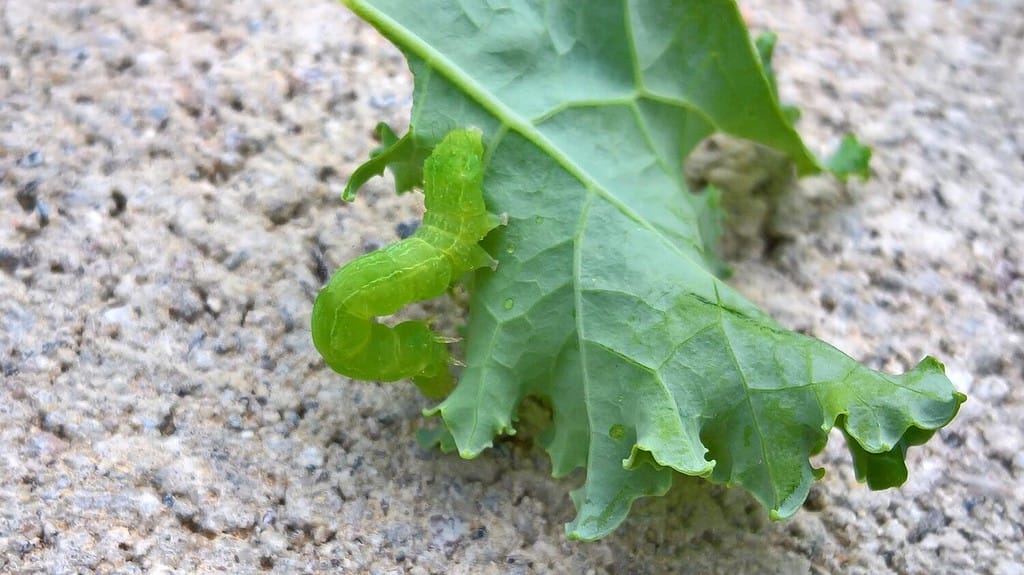
©amy71465/Shutterstock.com
6. Blinded Sphinx Caterpillar (Paonias excaecata)
Though its common name may suggest otherwise, these caterpillars do, in fact, have eyes. The species earns its common name for the black false eyes that are present on the wings of the adult moth. Like the caterpillar of the five-lined sphinx moth, this species also employs mimicry as a method of tricking potential predators.
The caterpillar has a broad, flat face and a body that is largely bright, neon green with darker green spots and markings. Small, white dots freckle its entire body. Caterpillars spend their larval stage feeding on deciduous trees and shrubs, like willows, birches, and rose bushes before finally burrowing underground to begin their metamorphosis. It’s a good thing they get to eat plenty of food before pupating, as the adult moths have no mouths to eat with!

7. Pipevine Swallowtail Caterpillar (Battus philenor)
While pipevine swallowtail butterflies (Battus philenor) are orange-spotted and strikingly iridescent, their larval form stands out for a completely different reason. The youngest of these caterpillars have many short, orange bumps, called tubercles, that cover their bodies. As they molt and progress through their instars, or life stages, these tubercles grow longer and more pronounced. By their fourth instar, the final one before they pupate, several of these tubercles become significantly longer than the others, giving the caterpillars a horned appearance. At this stage, the caterpillars become quite glossy and, in Arizona specifically, tend to develop a deep maroon coloration in the heat.

©Sundry Photography/Shutterstock.com
8. Monarch Caterpillar (Danaus plexippus)
Most people are familiar with the iconic monarch butterfly and its beautiful stained-glass wings. But did you know that its larval form is just as striking? This species of caterpillar flaunts a multitude of highly contrasting, horizontal stripes in green, black, and white. This high-contrast color scheme serves to warn potential predators of the caterpillar’s poisonous nature.
Yes, that’s right — poisonous. While most other caterpillars inject their toxin and are therefore venomous, monarchs are toxic only when ingested. Otherwise, they are harmless. Interestingly enough, the monarch caterpillar doesn’t even produce its own toxin! As it chows down on its only food source, milkweed, its body retains the toxic cardenolides within and carries them into adulthood.

©Cathy Keifer/Shutterstock.com
9. Two-Tailed Swallowtail Caterpillar (Papilio multicaudata)
How could any list of Arizona caterpillars be complete without the state insect? The two-tailed swallowtail butterfly (Papilio multicaudata) puts on quite a show, but its larvae are interesting as well. Caterpillars of this species make great use of mimicry, changing appearance drastically as they grow. They are very easy to miss in their first instar. Their irregular shape and brown-and-white coloration give them the resemblance of bird droppings. They eventually lose this coloration, turning bright green and eventually red with age. The segment directly behind the head begins to swell and develops two false eyes, giving the insect the appearance of a snake. To complete the charade, the caterpillar makes use of a special organ called an osmeterium when it feels threatened. This forked appendage extends from behind the caterpillar’s head and resembles a snake’s tongue. It emits a strong, foul odor to help repel the threat.

©Jorge Armín Escalante Pasos / CC BY 4.0 – Original / License
10. Puss Caterpillar (Megalopyge opercularis)
This fluffy-looking caterpillar (Megalopyge opercularis) is in the larval stage of the beautiful southern flannel moth. It is a pretty common caterpillar in Arizona. If you encounter this caterpillar in the wild, you definitely don’t want to touch it. While it may look soft and harmless, the puss caterpillar can be quite painful to pick up. Beneath the thick tufts of setae, or bristly hairs, the caterpillar hides a number of sharp, defensive spines. If an animal tries to eat or harm the caterpillar, the brittle spine tips break off in the offender’s skin and release a potent venom.
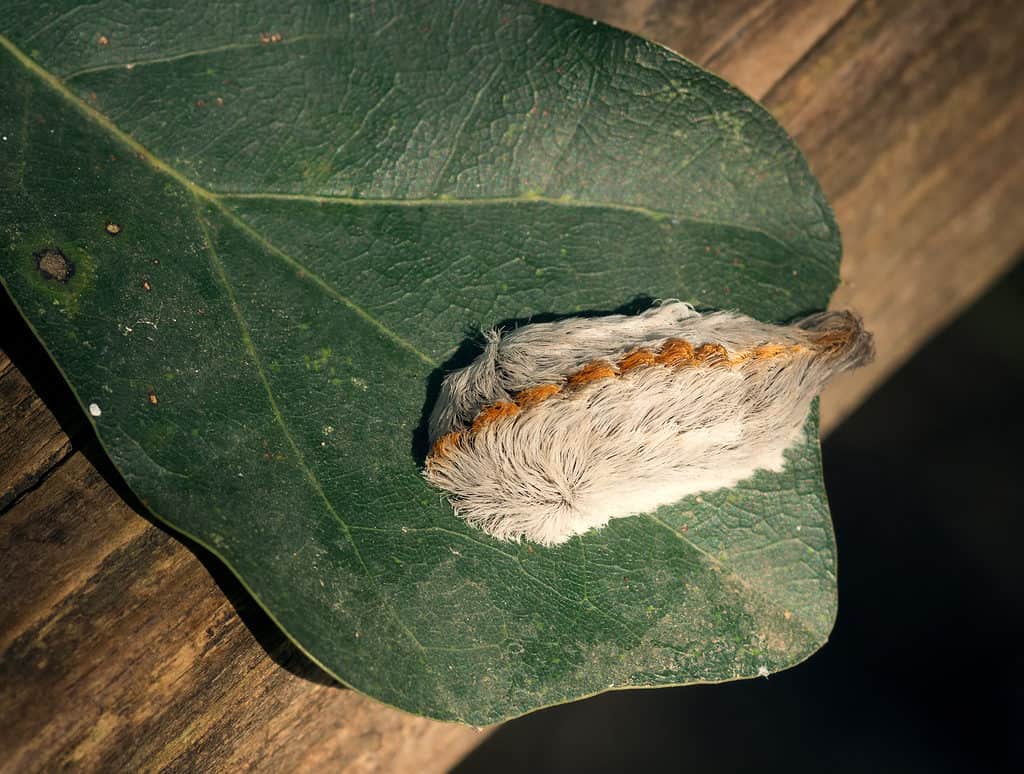
©IrinaK/Shutterstock.com
Thank you for reading! Have some feedback for us? Contact the AZ Animals editorial team.

